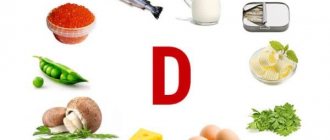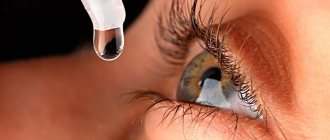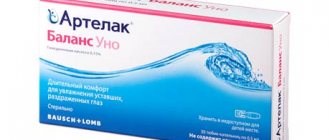Plants that improve vision
Berries in any form:
blueberries, wild strawberries, viburnum, cranberries, blueberries, princelings, cloudberries.
Vegetables in any form (including fresh juice):
potatoes, cabbage, carrots, tomatoes, turnips, onions, wild garlic.
Fruits in any form:
rowan, viburnum, black currant, sea buckthorn, rose hips.
Young shoots (in salads, soups):
nettle, primrose, dandelion (pre-douse with boiling water).
What is the essence of pathology
In a healthy eye, intraocular pressure is maintained at a normal level by balancing two processes - the formation of aqueous humor and its outflow. If this balance is disturbed, intraocular fluid accumulates in the cavities of the eyeball and puts pressure on the optic nerve, retina and lens.
Difference between types of glaucoma
Glaucoma can have two forms - open-angle and closed-angle. In the first case, the natural channels for the outflow of intraocular fluid are open, but narrowed or “clogged”, and in the second they are firmly blocked by the iris. In this case, it is impossible to cure glaucoma without surgery.
Most often, people are faced with a chronic open-angle form of glaucoma, which can exist for many years. Its course is associated with a slow increase in the volume of fluid and its slow outflow through the angle of the anterior chamber of the eye.
Patients note narrowing of peripheral vision, deterioration in the ability to see in the dark, mild headaches, blurred vision and the appearance of halos over light sources. Without treatment, the disease progresses, and over time the person begins to see only shadows. Vision becomes hazy and resembles a landscape picture through foggy glass.
There is no specific cause of glaucoma. It is believed to be caused by a variety of factors: lack of nutrition, toxins, certain medications, high levels of stress, heredity, other ophthalmic or systemic diseases, and metabolic disorders as the body ages.
There are many drugs of synthetic origin for the treatment of glaucoma. They inhibit the production of aqueous humor of the eye and improve fluid drainage through the trabecular meshwork of the anterior chamber angle. The same should be achieved when treating glaucoma at home.
Infusions from plants
Rose hip. 1 tbsp. l. dry ground fruits per 2 tbsp. boiling water, boil for 10 minutes, leave for 2-3 hours; take 1/4–1/2 tbsp. 3–4 times a day.
Black currant. 3–5 g of dry leaves per 1 tbsp. boiling water, steam for 10–20 minutes, strain; take 1/2–1 tbsp. 2-3 times a day as tea.
Strawberries. 20 g of dry crushed raw materials (leaves and fruits) per 1 tbsp. boiling water, boil for 5–10 minutes, leave for 2 hours; take 1 tbsp. l. 3 times a day.
Dandelion. 6 g of dry crushed raw materials (roots and grass) per 1 tbsp. water, boil for 10 minutes, leave for 30 minutes; take 1 tbsp. l. 3 times a day before meals.
Nettle. 7 g of dry crushed herb per 1 at. Boiling water, steam for 15–20 minutes; take 1 tbsp. l. 3 times a day.
Knotweed (bird knotweed). 20 g of dry chopped herb per 1 tbsp. boiling water, steam for 10–15 minutes; take 1 tbsp. l. 3–4 times a day.
Swamp calamus. 1 tbsp. dry crushed raw materials per 1 tbsp. boiling water, boil for 20–30 minutes; take 1 tbsp. l. 3 times a day.
Creeping wheatgrass. 4 tbsp. dry well-chopped rhizomes per 5 tbsp. water, boil until volume reduces by 1/4; take 1 tbsp. l. 4–5 times a day.
Schisandra chinensis. Schisandra tincture (pharmaceutical preparation) take 20–30 drops 2 times in the morning.
Motherwort. Take motherwort tincture (pharmaceutical preparation) 30–40 drops 2–3 times a day, mainly in the afternoon. Infusion: 15 g of dry crushed herb per 1 tbsp. boiling water, leave for 30–40 minutes; take 1 tbsp. l. 2-3 times in the afternoon.
Aloe. Juice (pharmaceutical preparation) take 1 tsp. 2-3 times a day 20-30 minutes before meals. Fresh juice too.
What is glaucoma?
Glaucoma is a broad group of ophthalmological diseases associated with increased intraocular pressure. It can constantly be above the norm or rise sporadically: a doctor can judge this only on an individual basis, because everyone has their own blood pressure standards.
Due to increased pressure inside the eye, vision changes for the worse: visual field defects appear, acuity decreases, and the optic nerve ceases to cope with its functionality. If left untreated, glaucoma can lead to complete loss of vision.
In total, this group includes about 60 different pathologies.
Why does pressure in the eye increase?
The condition of increased pressure in the eye is called ocular hypertension. It is caused by a violation of the outflow of fluid from the eye, as a result of which the eye is subjected to constant significant stress from the inside.
Glaucoma is considered a multifactorial disease, i.e. its appearance is due to several reasons. These include:
- anatomical features of the ocular apparatus;
- eye injuries and tumors;
- hereditary predisposition;
- atherosclerosis;
- hypertension;
- diabetes mellitus and some other endocrine pathologies;
- cervical osteochondrosis;
- inflammatory and infectious ophthalmological diseases;
- farsightedness;
- surgical operations on the eyes.
Secondary glaucoma develops against the background of diseases associated with the ocular apparatus: iridocyclitis, uveitis, keratitis, scleritis, iris atrophy, hemophthalmos and others.
Treatment of eye diseases with medicinal plants
Preparations prepared from medicinal plants are used quite widely in modern ophthalmology. However, they are usually complementary therapies. The fact is that eye disease is often just one manifestation of the condition of the body as a whole (for example, a disease such as diabetes). Therefore, treatment aimed at the underlying disease also improves vision. Improvement can also be achieved by targeting certain symptoms of the disease.
| Diseases | Recommended Treatment |
| Diseases of the visual field associated with general weakening of the body (or against the background of low-grade inflammatory processes) | Medicinal plants that stimulate the central nervous system (schisandra chinensis fruit, ginseng root, eleutherococcus root) |
| Glaucoma, hypertensive changes in the fundus, inflammatory processes in the eyes | Medicinal plants with a diuretic effect (bearberry leaves, lingonberries, strings, rowan fruits) |
| Diseases of the visual organs associated with hemorrhages in the retina, vitreous body, under the conjunctiva of the sclera | Medicinal plants with a hemostatic effect (corn silk, stinging nettle leaf, viburnum bark, arnica flower) |
| Retinal diseases associated with hypertension | Medicinal plants that lower blood pressure (fruits of chokeberry, leaves of magnolia grandiflora) |
| Age-related sclerotic changes in the retina | Medicinal plants that have an anti-sclerotic effect (fruits and leaves of hawthorn, rose hips, seaweed, onions, garlic, wild strawberries) |
| Diabetic retinal changes | Medicinal plants that have a sugar-lowering effect (corn silk, blueberry leaves, dandelion root, beans) |
Medicinal effect and properties
The positive effect of taking such monastery tea can already be felt after a few weeks. In some cases, monastery tea is more effective in treating diseases than drops or tablets. With the help of a unique healing composition, tea has the following effects on the eyes:
- normalizes blood circulation processes in the visual system;
- helps reduce tension in the eyes;
- has strengthening properties on vascular walls;
- has a positive effect on the process of restoration and regeneration of the retina;
- is able to eliminate pain and pain in the eyes;
- has an effect on improving focusing;
- normalizes the tone of the eye muscle;
- prevents sclerotic changes in the retina;
- saturates with vitamins beneficial for vision.
Share with your friends
Remember!
- Treatment with medicinal plants must be agreed upon with the attending physician (especially in the presence of serious eye diseases, such as glaucoma, inflammatory processes, etc.)
- The duration of treatment with the same drug should not exceed one and a half months. Then you need to switch to a drug with a similar effect.
- In case of intolerance (allergy, gastrointestinal disorders), it is necessary to replace the drug with another one with a similar effect.
- Buy herbal preparations only in pharmacies!
- Collect only those plants that you know well.
- Within the city limits, near highways, railways, and agricultural lands, it is prohibited to collect medicinal and plant raw materials!
«>
Types of medicinal herbs for vision
All medicinal herbs that are used to improve and restore vision are divided into the following groups:
- Herbs of general action. Such drugs affect the speed of metabolic processes, the tone of nerve structures, the elimination of toxins, improve the general condition of the body and can be used for various pathologies.
- Vitamin products. These are medicinal herbs that contain a certain vitamin in large quantities. Typically, such herbs are used for diseases that are associated with a deficiency of the corresponding substance. In ophthalmology, they are often used for keratitis, farsightedness, myopia, atrophy, and optic neuritis.
- Anti-inflammatory herbs. This category includes herbal medicinal products that have a pronounced anti-inflammatory effect. They are used in the treatment of blepharitis, conjunctivitis and keratitis.
- Special herbs. This group of herbal remedies and preparations is used for specific diseases: cataracts or glaucoma.
Antiseptic herbs for washing eyes
The situation of slight souring of the eyes in the morning is familiar to everyone. There is no problem with this.
The tear fluid produced resists minor pathogens that enter the eyes with the wind, through contact with dirty hands, etc. As a result, after waking up, lumps of mucus are found in the corners.
However, the antiseptic properties of tear fluid are not enough. In such cases, you can use the following herbs:
- 2 tbsp. pour 250 milliliters of boiling water over the original product;
- leave for half an hour;
- remove the grounds.
- combine the root of the herbaceous plant with boiled, cooled water (proportions - 6 grams per glass, respectively);
- leave the duet for 1/2 day;
- separate the healing liquid.
The described means are applicable when washing the eyes. They can also be used for lotions and compresses.
Herbal decoctions for the eyes
Most remedies are prepared by infusing the original plant material. This is explained by the harmful effects of boiling on beneficial substances. However, some herbs are difficult to “give up” their valuable components. When using them, preference should be given to preparing decoctions.
The main recommendations are in the following aspects:
- using minimal heat;
- simmering duration - up to 7 minutes (exceeding the time recommendation leads to loss of value, decreasing - insufficient enrichment of the decoction with useful components).
Herbal eye drops
You can prepare herbal drops yourself at home (the most common herbal remedy is aloe juice).
An alternative option is to buy a ready-made drug at a pharmacy. Modern pharmaceutical companies offer a large variety of them.
Advantages of this product:
- optimal combination of components;
- the presence of clear instructions indicating the scheme of use, indications and contraindications;
- production quality control.
The price may vary: it starts from approximately 200 rubles, and the upper limit exceeds 1000 rubles. The effect provided is soft and gentle. In difficult situations, it may not be enough for treatment without the parallel use of more serious medications.
Collection and procurement of raw materials
In folk treatment for nettle preparations, specialists usually use leaves, seeds, roots and stems of plants. Raw materials should be collected during the flowering period, that is, in the summer months. It is best to collect nettles in dry, sunny weather so that the leaves are dry. Collecting roots should be done in spring or autumn. Seeds are collected two weeks after the plant blooms. If you plan to use nettle leaves in cooking, then you can pick them in early spring.
It is better to collect nettles with gloves
Before you start collecting, you must protect your hands with gloves. When harvesting large volumes, you can use a sickle or scythe. To prepare the roots, nettles should be pulled out, washed with water and the stems cut off. To harvest nettle seed with all its medicinal properties, you should tear off the top part of the grass and thresh it a little later.
It is important to know! Collecting plants that grow along highways, railway tracks, industrial zones, and garbage dumps is prohibited.
To dry the leaves, you need to choose a room with good ventilation and where the sun's rays do not penetrate. Due to exposure to sunlight, nettle may lose its beneficial properties. The best place for drying is an attic, shed or terrace. Raw materials can be laid out on plywood, paper or fabric. The layer should be no more than 3-4 centimeters. The herb will be considered completely dried and ready for preparing decoctions when its petals break with a crunch.
You can buy nettle leaves at the pharmacy
Dried leaves can be stored in paper bags or boxes. Properly prepared raw materials will retain their beneficial properties for 2 years.
Causes and treatment of myopia
Myopia, the causes of which are very diverse, but familiar to all people, is an eye disease manifested by visual impairment with its change in the direction of worsening vision of objects located at a distance, while maintaining vision of near objects. There is another name for this pathology - myopia. It is more applicable in medicine to formulate an appropriate diagnosis.
The incidence of myopia is quite high: every third or fourth person on our planet has this disease. More often, it begins its development in primary school age and in high school, and in the future it can worsen its course or stop at the level that arose during this period.
With myopia, a violation of the refraction of the light ray by the lens of the eye occurs, and the image begins to be projected not on the retina itself, which should be normal, but in front of it.
Thus, the focal point is located in front of the retina, and a person sees well only objects close to him.
Today, the following types of myopia are distinguished:
- Weak (characterized by vision up to 3.0 dp).
- Moderate degree (characterized by vision of 6.0 dp).
- High degree (characterized by vision of more than 6.0 dp).
Low and moderate myopia are no more aggressive than high myopia and can be almost completely corrected with lenses. In addition, moderate myopia causes changes in the fundus of the eye in the form of narrowing of blood vessels, which is necessarily detected by an ophthalmologist at an appointment.
Additional types based on the rate of development of this disease include progressive myopia, which reaches 30.0-35.0 dp and is complicated more often, and non-progressive, which does not require therapy and does not develop so rapidly. Additionally, temporarily progressive myopia was identified, which also proceeds steadily and favorably.
The most common causes of myopia
- hereditary causes (predisposition) - the presence of myopia in parents or close blood relatives;
- prolonged work with objects located close to the eyes (writing, sewing, knitting, etc.);
- eye strain when reading in a dimly lit room, sitting at a computer or watching TV;
- change in intraocular pressure towards its increase or decrease;
- thinning of the sclera (the white membrane of the eye);
- congenital predominance of the length of the anteroposterior size of the eyeball over the superior-inferior;
- congenital change in corneal shape;
- intoxication of the body;
- trauma during childbirth;
- traumatic brain injuries;
- malnutrition with a deficiency of micro- and macroelements, vitamins, nutrients;
- hormonal changes.
In addition to focusing on the main symptoms of myopia, which are a noticeable decrease in vision, moving a book closer while reading it, trying to sit closer to the TV while watching it, squinting of the eyes, a feeling of excessive overstrain of the eye muscles, eye fatigue, periodic lacrimation, clouding of the visible picture, you can use a number of techniques that can answer the question of how to determine the presence and degree of myopia.
How to determine myopia yourself?
- independently monitor the state of your visual acuity and the time of occurrence of eye fatigue;
- pay attention to the clarity of the boundaries of objects around you, the presence of pain after long work that requires concentration;
- try to count the stars in the night sky while standing outdoors (with myopia, they appear to be blurry lights without clear boundaries, counting stars is impossible or difficult);
- read the lines in the newspaper, written in large font, gradually moving it away from your eyes, to realize how poorly you see the things around you;
- Be sure to consult an ophthalmologist and tell us about all observations of your vision: only an experienced specialist will know how to determine the treatment that is appropriate for you if the diagnosis is confirmed.
Any disease is much easier and simpler to prevent than to cure, so do not forget about preventive measures for myopia.
Moderate myopia can be prevented by daily observing the rules of individual vision hygiene (walks in the fresh air, breaks from work, reducing time spent at the computer), consuming vision-healthy foods in the diet (blueberries, currants, fish dishes, oranges, lemons, lutein ), doing exercises for the eye muscles, using sunglasses and caps to protect from sunlight, and high myopia.
The causes of myopia are usually the result of neglect of the above prevention methods. Despite this, myopia can be treated, and this treatment includes a variety of approaches and ways to get rid of the problem or reduce its symptoms.
Directions in the treatment of myopia
- corrective therapy with glasses, lenses, laser treatment;
- surgical intervention to replace the lens, plastic surgery on the cornea of the eye;
- electrical stimulation of the rectus and oblique muscles of the eyeball;
- drug treatment with pharmacological drugs (Emoxipin, Ujala, Irifrin, Taufon, Vita-Yodurol, Quinax, vitamin preparations);
- exercises in the form of specialized gymnastics;
- the use of folk remedies (blueberries, currants, rose hips, lingonberries, nettles, cornflowers, lotions with honey).
Home gymnastics for the eyes
- Stand in front of a glass window, focus your gaze on a point located on the glass itself for one minute, then look at the landscape outside the window.
- Extending either hand forward and raising one finger on it, focus on it, and then move the finger closer, without moving your gaze, and then look at the objects in the room.
- Watch your fingers as you move left and right.
- Blink quickly with both eyes for one minute.
- Alternately close your eyes and open your eyes.
People with high myopia are usually limited to using steam rooms and baths due to the increased risk of vascular rupture and hemorrhage. In addition, a limitation is observed in the professional activity of a myopic person: it is better to choose a profession that will not cause severe strain on the visual analyzer.
Myopia, regardless of the degree and cause, undoubtedly affects a person’s quality of life, taking away the opportunity to see the world around us in full colors. But by systematically engaging in its prevention and not excluding the possibility of this pathology occurring in any person, you can prevent the appearance of myopia in yourself.
Folk remedies using honey in the treatment of glaucoma
There are many recipes using honey. The simplest one is honey solution. Take the same ratio of honey and cold boiled water. Mix well. Rinse your eyes with this solution twice a day for a month.
Healing with honey and aloe is effective. Mix one teaspoon of ingredients, add a tablespoon of clean water. Instill the resulting solution one drop every evening.
Drops of fresh onion juice and honey are considered effective. Equal doses of ingredients are required for preparation. Mix for several minutes in a water bath. Cool, drop two drops into the eyes three times daily. Apply fresh drops every day.
Drops of honey and eggs give good results. To prepare: cut the egg in half, remove the yolk, add honey. After a day, liquid forms in the halves. Apply two drops of this liquid to your eyes in the morning and evening.
Methods of therapy at home
Treatment is aimed at reducing intraocular pressure and ensuring normal metabolism in the structures of the eye. Both medications and folk remedies are suitable for this.
Medicines
Medicines prescribed for glaucoma are selected taking into account the type of disease (open-angle or closed-angle, acute or chronic). They differ not only in symptoms, but also in the processes occurring in the ocular apparatus, therefore several groups of medications are prescribed for glaucoma:
- beta blockers (reduce the production of intraocular fluid);
- carbonic anhydrase inhibitors (reduce the production of an enzyme that promotes the production of intraocular fluid);
- sympathomimetics (increase the circulation of intraocular fluid);
- cholinomimetics (reduce IOP and improve the outflow of intraocular fluid);
- prostaglandins (improve the outflow of intraocular fluid).
Sometimes combination drugs are prescribed that have a more powerful complex effect.
Drops of Aceclidine, Travatan, Irifrin increase the outflow of fluid, and reduce its production - Timolol, Trusopt, Azarga, Azopt, Brinzopt.
Folk remedies
Folk remedies are not used as an independent method of treatment, but are often used as an auxiliary one. Despite the fact that in this case various medicinal herbs, berries and other natural ingredients are used, the use of certain recipes must be agreed with a doctor.
The treating ophthalmologist must know whether the patient uses alternative medicine for medicinal purposes in order to judge the effectiveness of prescribed medications and monitor the dynamics of glaucoma.
Useful video
Folk remedies for glaucoma:
For eye inflammation
The inflammatory process can be caused by a wide variety of diseases. Well-known examples are conjunctivitis, blepharitis, stye and many others. The choice of a therapeutic regimen for a specific problem should be made by a doctor.
Universal recipes for suppressing the inflammatory process are represented by the following options:
1. Chamomile infusion. Its preparation is similar to the option for eye allergies.
2.Composition based on lily of the valley flowers:
- pour the raw material with water at boiling point at the rate of a tablespoon per 100 milliliters of liquid;
- leave to infuse;
- When the composition reaches body temperature, remove the grounds;
- moisten cotton pads with the resulting product;
- apply to closed eyelids;
- stand for a quarter of an hour;
- repeat three times a day until symptoms disappear completely.
Prevention
One of the key points when fighting myopia at home, especially in teenagers and children. This is due to the fact that the eyeball continues to grow until adulthood, which means a higher risk of developing myopia compared to adults.
Therefore, it is important to follow all of the following tips for organizing your daily life:
- healthy regime,
- vision hygiene,
- proper nutrition,
- maintaining visual distance from objects when working and resting.
By paying attention to prevention, you can prevent the development of myopia, which is easier than treating it. But treating myopia at home also brings results, the main thing is to pay enough attention to it and follow all recommendations systematically
Plants have long been used to treat many diseases, be it a banal allergy or a serious illness. Currently, despite the huge number of pharmaceutical drugs, homeopathy has not yet lost its uniqueness - it is natural and effective.
Using herbs to improve vision is an ancient method of treating eye problems. They can treat both infections and conditions associated with myopia and farsightedness.
Indications for use
Herbal tea “Fitol-12” (to improve vision) is recommended for regular use as an auxiliary natural remedy that increases the effectiveness of prevention and complex treatment:
- Degenerative-dystrophic eye diseases (cataracts, glaucoma, macular degeneration, destruction of the vitreous, iris dystrophy, etc.)
- Hemeralopia (“night blindness”)
- Infectious and inflammatory diseases of the visual organs of various etiologies (blepharitis, keratitis, conjunctivitis, keratoconjunctivitis, etc.)
- Diabetic retinopathy and hypertensive retinal angiopathy
Herbal tea “Fitol-12” is also useful for:
- Asthenopathy (increased fatigue of the visual organs), common causes of which are intense loads on the visual apparatus (long-term work at the computer, long-term work under artificial lighting or long exposure to bright sunlight).
- Xerophthalmia
- Decreased visual acuity
- Color vision impairment
- Farsightedness
- Myopia
A course of treatment
You need to drink this healing drink regularly. Train yourself to start every morning with a cup of warm, aromatic tea. The decoction for improving vision has a pleasant taste and is very simple to prepare. It is enough to pour boiling water (200 ml) into a teaspoon of the mixture. The tea should brew for about ten minutes, after which it is filtered. The first course of treatment will take three weeks, then you should take a break.
By drinking a couple of cups a day, you will very soon feel the healing effect: weakened vision will gradually begin to improve. With long-term use of this miracle drink, the causes of poor vision will disappear, the body will become stronger, and visual acuity will remain until old age.
Agree, restoring vision without surgery is a wonderful chance given to us by nature itself!
Recommendations
Achieving maximum effect and minimizing the likelihood of side effects requires following simple tips:
- carefully straining herbal remedies (fine particles can get into the eyes and lead to discomfort and sometimes even injury);
- temperature control (will help avoid hypothermia and burns);
- refusal to use the product even if there is a slight negative reaction to it;
- the maximum duration of use of one product is 1.5 months (after this time it must be replaced with a similar one);
- purchasing herbal raw materials at pharmacies;
- collecting herbs in environmentally safe areas (in case of self-harvesting);
- taking into account the contraindications of each of the plants used.
Traditional medicine offers many herbal-based recipes for eye treatment. However, their use must be judicious.
Choosing the best option, determining a therapeutic regimen, and monitoring dynamics should be the responsibility of the ophthalmologist.
People have been using plants to cure diseases and various ailments since ancient times. Herbs for vision (restoring or improving it) are just one of the many elements that we can use thanks to the natural pharmacy that surrounds us.











